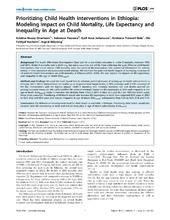| dc.contributor.author | Onarheim, Kristine Husøy | en_US |
| dc.contributor.author | Tessema, Solomon | en_US |
| dc.contributor.author | Johansson, Kjell Arne | en_US |
| dc.contributor.author | Eide, Kristiane Tislevoll | en_US |
| dc.contributor.author | Norheim, Ole Frithjof | en_US |
| dc.contributor.author | Miljeteig, Ingrid | en_US |
| dc.date.accessioned | 2013-04-10T09:33:22Z | |
| dc.date.available | 2013-04-10T09:33:22Z | |
| dc.date.issued | 2012-08-07 | eng |
| dc.Published | PLoS ONE 7(8): e41521 | eng |
| dc.identifier.issn | 1932-6203 | |
| dc.identifier.uri | https://hdl.handle.net/1956/6499 | |
| dc.description.abstract | Background: The fourth Millennium Development Goal calls for a two-thirds reduction in under-5 mortality between 1990 and 2015. Under-5 mortality rate is declining, but many countries are still far from achieving the goal. Effective child health interventions that could reduce child mortality exist, but national decision-makers lack contextual information for priority setting in their respective resource-constrained settings. We estimate the potential health impact of increasing coverage of 14 selected health interventions on child mortality in Ethiopia (2011–2015). We also explore the impact on life expectancy and inequality in the age of death (Ginihealth). Methods and Findings: We used the Lives Saved Tool to estimate potential impact of scaling-up 14 health interventions in Ethiopia (2011–2015). Interventions are scaled-up to 1) government target levels, 2) 90% coverage and 3) 90% coverage of the five interventions with the highest impact. Under-5 mortality rate, neonatal mortality rate and deaths averted are primary outcome measures. We used modified life tables to estimate impact on life expectancy at birth and inequality in the age of death (Ginihealth). Under-5 mortality rate declines from 101.0 in 2011 to 68.8, 42.1 and 56.7 per 1000 live births under these three scenarios. Prioritizing child health would also increase life expectancy at birth from expected 60.5 years in 2015 to 62.5, 64.2 and 63.4 years and reduce inequality in age of death (Ginihealth) substantially from 0.24 to 0.21, 0.18 and 0.19. Conclusions: The Millennium Development Goal for child health is reachable in Ethiopia. Prioritizing child health would also increase total life expectancy at birth and reduce inequality in age of death substantially (Ginihealth). | en_US |
| dc.language.iso | eng | eng |
| dc.publisher | Public Library of Science | eng |
| dc.rights | Attribution CC BY | eng |
| dc.rights.uri | http://creativecommons.org/licenses/by/2.5/ | eng |
| dc.title | Prioritizing Child Health Interventions in Ethiopia: Modeling Impact on Child Mortality, Life Expectancy and Inequality in Age at Death | en_US |
| dc.type | Peer reviewed | |
| dc.type | Journal article | |
| dc.description.version | publishedVersion | en_US |
| dc.rights.holder | Copyright Onarheim et al. | |
| dc.identifier.doi | https://doi.org/10.1371/journal.pone.0041521 | |
| dc.identifier.cristin | 962872 | |

